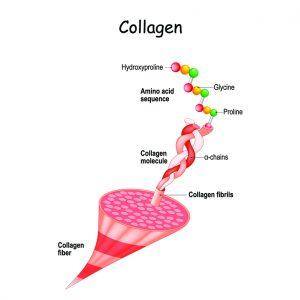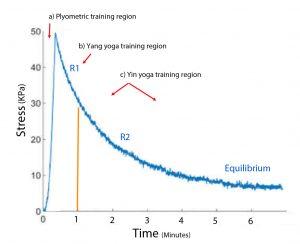By Bernie Clark, March 18th, 2021

Fascia fascinates yin yoga teachers and students. That is understandable because yoga affects our fascia, and yin yoga in particular targets fascial structures like ligaments, tendons and joint capsules. If you love to learn about anatomy and physiology, you have no doubt come across the mystical term viscoelasticity. But, you may not fully understand what it means. Here is your chance to learn a bit about the viscoelastic nature of our fascia and how it can inform our yoga practice.
Elasticity
Fascia can be quite elastic: it can stretch and recoil. The recoil movement returns most of the energy that was used to stretch the fascia. This is one of the reasons humans are the bouncing primates. We use the elasticity in our fascia to run, jump and throw efficiently. Other primates have to use their muscles more than us to generate their movements, but we can store up energy in our stretched fascia so that it snaps back and helps us move quickly. This is the very definition of elasticity: the energy used to stretch a material is returned when the material is allowed to relax. A material that returns more energy is said to be more elastic than a material that returns less energy.[1]
There is a principle taught in biomechanics called SAID, which stands for specific adaptation to imposed demand. It means that our tissues adapt to the loads we place upon them. SAID applies to the elasticity of our fascia as well. Dr. Robert Schleip has shown that we can train the amount of bounce we get from our fascia by bouncing[2]. This practice has a technical sounding name: plyometrics[3]. (The people who jump onto boxes are practicing plyometrics. They are training the elasticity of their fascia as well as the strength and speed of their muscles.) We can definitely see that fascia is elastic, which is the second part of the word viscoelastic, but what is viscosity?

Viscosity
We have all noticed that some liquids flow more easily than others. Pouring tea from the pot into your cup is quick and easy. Dripping a teaspoon of honey into your tea takes longer. Honey is more viscous than water. Viscosity is a term usually applied to liquids or gases and it refers to resistance of flow. Something with high viscosity has a high degree of internal friction and doesn’t flow easily. A fluid with low viscosity does flow easily because the internal bonds between the molecules within the fluid are not very strong. Viscosity can be affected by temperature: as a fluid is warmed the strength of the bonds between the molecules weakens, which allows the fluid to flow more freely. This is one reason why athletes are advised to warm up before their sports: it will decrease their tissues’ viscosity, which will increase their range and ease of motion.
It would seem, on the surface, that elasticity and viscosity are referring to very different things: a teaspoon of honey is nothing like a stiff elastic band. However, there are materials that possess both attributes. One such material is our fascia: it is viscoelastic. Fascia can be purely elastic or it can be highly viscous. Another example is the child’s toy called Silly Putty. If you form Silly Putty into a ball and throw it on the floor, it will bounce: that reflects its elasticity. A viscoelastic material when confronted with a sharp, sudden force will behave elastically. However, if you slowly pull both ends of the Silly Putty it will deform and lengthen. When subjected to a slow force over a long time, a viscoelastic material will behave viscously and slowly stretch.
A quick, counter movement will initially stretch fascia but then it will rebound back to its original length. This is why box jumpers will first squat down before leaping up: the squatting loads or stretches the fascia. The Kundalini version of fast, bouncy Frogs allows your fascia to behave elastically. However, when you “melt” into Butterfly pose for several minutes, you can feel your fascia letting go as you head towards deeper edges. This is its viscous nature.
A pasta and rice analogy
Imagine a box of long, thin strands of spaghetti: when you open the box and pour the spaghetti into a pot, each strand easily slides out of the box. However, imagine there were bits of sticky rice in the box that glued the strands of spaghetti together[4]. Now, the individual stands would not easily or quickly flow into the pot: all the spaghetti would move as one pile of pasta. Our fascia is somewhat like that. A ligament or tendon consist of collagen fibers, which, as shown in figure 1, are made up of collagen fibrils, which in turn are made up of twisting, intertwined collagen molecules or microfibrils, which are built up from a repeating array of three amino acids. Think of the collagen fibrils as the spaghetti in our analogy. Each grain of sticky rice is a covalent bond between the fibrils’ molecules. (What is a covalent bond? Imagine two lovers sharing one ice cream cone. To eat it they have to stay close together. A covalent bond is an electrical attraction between two molecules that arises when they share an electron between them. They stay close together.) The covalent bonds are referred to as cross-links. The more cross-links, the less mobile and more viscous the collagen behaves[5].

Not shown in figure 1 are the wavy curves that occur along the whole length of the collagen fiber. This is called crimp and can vary in presentation from a zigzag pattern to sinusoidal[6]. Thus, to refine our pasta analogy, consider the spaghetti to be more like skinny mafaldine or reginette noodles.
Let’s return to our Silly Putty example: the spaghetti in the Silly Putty is a long collagen-like molecule called polymethylsilicane. The sticky rice is a molecule of borax. (Don’t worry: these names won’t be on the test[7].) There are a few analogues for the sticky rice as well, such as proteoglycans. These are chains of water, bound by water loving molecules, like hyaluronic acid, that form a watery gel in our fascia. The second counterpart to sticky rice is a covalent attraction between the molecules of collagen in the fibrils. These covalent cross-links are similar to the cross-links between the fibers that make up Silly Putty.
Imagine you are slowly trying to stretch a ball of Silly Putty. If the tension created by pulling on the material is higher than the cross-links bond’s strength, then the cross-links release allowing the fibers to slip against each other. This would result in the lengthening of the whole ball of Silly Putty. The more bonds that break, the longer the material becomes. However, it takes time for the bonds to form or release. If you suddenly tried to pull the ball apart it would resist: the bonds would not have time to release so they would hold the ball tightly together. This is why a ball of Silly Putty bounces: the time spent hitting the floor is very brief and the bonds do not release that quickly.
In the same way, our viscoelastic fascia is highly elastic when presented with a sudden stress. The covalent bonds between the collagen molecules and the water in our fascia stay engaged and they react elastically to sudden forces. If the force is a lot stronger than the bonds, the material still wouldn’t stretch, it would shatter. Like a crystal vase launched to the floor, the sudden severing of the bonds would be a catastrophic ending. Anyone who has sprained an ankle or torn a tendon or ligament knows how this feels. The tissues do not recover quickly from a large, sudden stress. This is analogous to snapping your Silly Putty in two.
However, when a long held stress occurs several things happens: the wavy crimp along the fibers flattens, which lengthens the fibers; the individual molecules within the fiber unwind; and the covalent bonds (the sticky rice) slowly let go allowing the fibers to slide along each other. Also, the proteoglycans release their water molecules under sustained stress, which liquefies the gel and allows more lengthening. The water molecules can also rotate or change their alignment, which also reduces their bond strength[8]. All this results in the viscous deformation of the fascia over time.
Fascia rebound
Unlike Silly Putty our fascia will rebound after the long, slow pulling ends. The covalent bonds reform, the proteoglycans hug the water molecules again and the fascia returns to its original length. Robert Schleip believes that during the transition of the water from gel to liquid (called the sol state) and back to the gel state, therapy occurs. Toxins and free radical that were embedded in the gel are released, flow into the lymph system and are removed from the body. Cleaner water forms the new gel[9].
The slow breaking of the bonds results in a relaxation of the tissues. This is a technical use of the word relaxation and refers to a reduction of internal stress within the tissues that occurs when the tissues are held at a constant, stretched length for a period of time. The rate of relaxation can vary in a viscoelastic tissue, with two main rates predominating. The first rate, we can call it R1, is a rapid relaxation of internal stress and lasts for about one minute. Scientists call this the “short relaxation time”. After that there is a slower rate of relaxation, R2, that can last up to 30 minutes depending upon the tissue. This is called the “long relation time”[10]. Eventually, the internal stress will equal whatever external stress is being applied to the tissues and we reach equilibrium. This relationship is shown in figure 2.

Notice in figure 2 that there is an initial, sharp increase in internal stress once a load is applied to the tissues. This is the period of elasticity. Viscoelastic materials stiffen when a fast load is experienced. But, once the load is left to linger, then the internal stress levels start to reduce, more quickly at first (R1), but then it slows down (R2) until equilibrium is reached. The values of R1 and R2 vary by tissue type and location. Carla Stecco has reported that for the lower leg’s fascia (crural fascia), almost 90% of the relaxation occurs within the first minute of stress and almost 100% occurs within four minutes[11]. Overlaid onto figure 2 are three forms of exercise: brief, transient stretches, which occur during plyometric exercises; short term stresses, which are held for up to one minute in most yang forms of yoga (regular Hatha or Vinyasa classes); and longer stresses, which are common in yin yoga classes.
Fascia during yoga
Most yogis have experience the two rates of relaxation: R1 and R2. In more active, yang-styles of practice, postures are held for up to one minute (about the time it takes for five breaths). That is enough time for the initial relaxation to occur. In yin yoga, where the poses are held much longer, there is time for the secondary relaxation to occur and equilibrium to be achieved.
Internal tissue relaxation is related to another factor of viscoelastic materials: creep. Creep is the elongation that occurs under a constant force over time[12]. Stick your blob of Silly Putty to a wall and after a few hours it will have drooled down the wall. Our fascia can also creep when subjected to a long held force. We notice creep in our yoga practice when we feel more flexible or have a greater range of motion. We notice relaxation when it takes less effort to remain at the same depth in a pose.
When we perform a counterpose, or lie still enjoying the rebound after a long held posture, or when we savour shavasana, we may experience the re-bonding of collagen molecules and the rehydration of our fascia. Creep reduces and the internal tissues’ stresses rebuild. It may take an hour or longer to fully recover, but that depends upon how deeply we stressed our tissues and for how long. If we went too far, we may have ruptured some of our tissues, creating micro-fractures in the fascia. This creates a plastic deformation of our tissues: they don’t return to their original length. This is not merely the breaking of bonds between fibers, but the breaking of the fibers. Over times, and it could take days, weeks or even months, the tissue will heal, but this is the danger of taking our tissues beyond their viscoelastic limits. Overstretched tissues become plastic. This is not necessarily bad or dangerous: microfractures may stimulate the body to rebuild the tissues to a stronger level than before. However, if pain is present and persists, you probably went too far.
Ideally, we want our tissues to remain viscoelastic, and through the principles of SAID, our yoga practice can help to develop our fascial viscoelasticity.
[1] Note: this is not saying that a material that is stretchier is more elastic! Compliance is the term used to indicate how stretchy something is. Compliance and elasticity are inversely proportional: something that has high compliance and is easily stretched has low elasticity and won’t snap back very fast. Something that has high elasticity is not easily stretched and has low compliance, but it will snap back quickly. A tight spring is more elastic but less compliant than a floppy elastic band.
[2] See Fascial Fitness by Robert Schleip, North Atlantic Books; 2nd edition (July 6, 2021).
[3] “Plyo” is Greek and means, “to increase”. “Metric” is also Greek and means, “to measure”. Thus, plyometrics is a way to increase the measure of your performance.
[4] Thanks to Wayne Schmidt for this analogy.
[5] To be more technical, there are also non-covalent bonds between collagen. These links are quite weak and can be broken simply by an increase in temperature. They are called transient bonds and are often found between the collagen fibers inside our cells.
[6] See Wan, C., Hao, Z. & Wen, S. A review on research on development of ligament constitutive relations on macro, meso, and micro levels. Acta Mech. Solida Sin. 26, 331–343 (2013).
[7] And, there is no test!
[8] See Shen ZL, Kahn H, Ballarini R, Eppell SJ. Viscoelastic properties of isolated collagen fibrils. Biophys J. 2011 Jun 22;100(12):3008-15. doi: 10.1016/j.bpj.2011.04.052. PMID: 21689535; PMCID: PMC3123930.
[9] See Schleip R, Müller DG. Training principles for fascial connective tissues: scientific foundation and suggested practical applications. J Bodyw Mov Ther. 2013 Jan;17(1):103-15. doi: 10.1016/j.jbmt.2012.06.007. Epub 2012 Jul 21. PMID: 23294691.
[10] See Shen ZL, et. al.
[11] See Stecco C, Pavan P, Pachera P, De Caro R, Natali A. Investigation of the mechanical properties of the human crural fascia and their possible clinical implications. Surg Radiol Anat. 2014 Jan;36(1):25-32. doi: 10.1007/s00276-013-1152-y. Epub 2013 Jun 21. PMID: 23793789.
[12] Creep and relaxation are related but not the same. Relaxation occurs when a tissue is held at a constant length for time; creep occurs when a tissue is held under a constant load for time. To maintain the same length (called strain) for time, a reducing amount of stress is required, which is relaxation; however, if the same amount of stress is maintained then length increases, which is creep.
